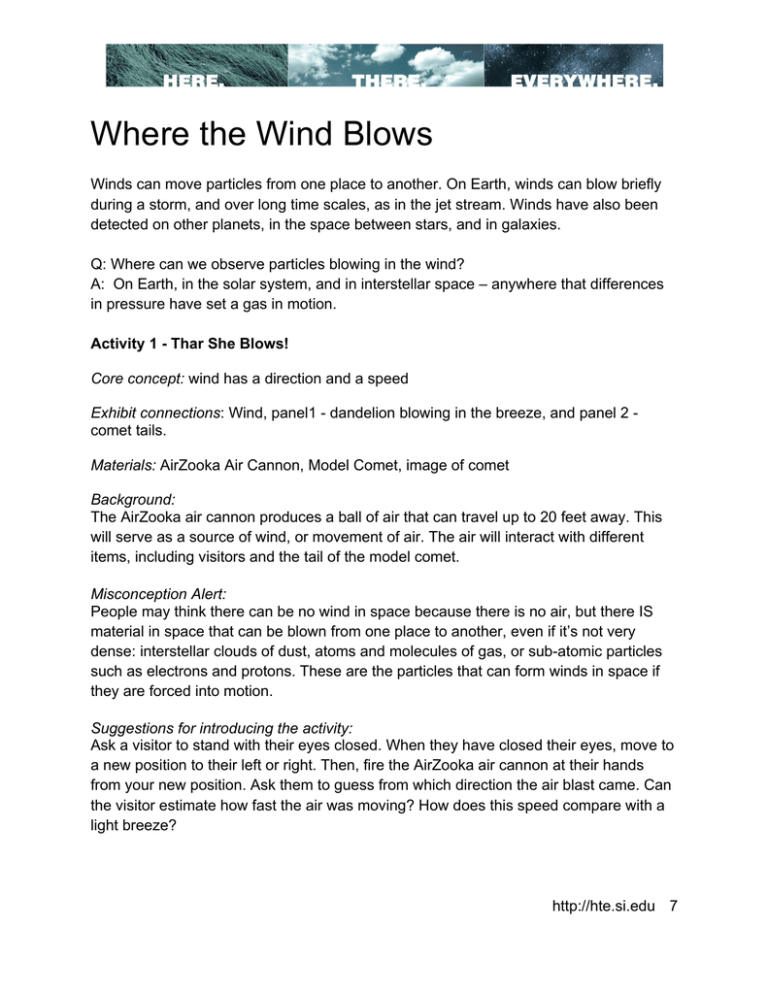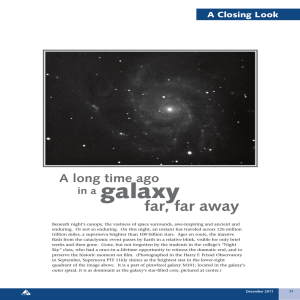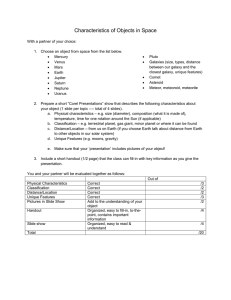Where the Wind Blows
advertisement

Where the Wind Blows Winds can move particles from one place to another. On Earth, winds can blow briefly during a storm, and over long time scales, as in the jet stream. Winds have also been detected on other planets, in the space between stars, and in galaxies. Q: Where can we observe particles blowing in the wind? A: On Earth, in the solar system, and in interstellar space – anywhere that differences in pressure have set a gas in motion. Activity 1 - Thar She Blows! Core concept: wind has a direction and a speed Exhibit connections: Wind, panel1 - dandelion blowing in the breeze, and panel 2 comet tails. Materials: AirZooka Air Cannon, Model Comet, image of comet Background: The AirZooka air cannon produces a ball of air that can travel up to 20 feet away. This will serve as a source of wind, or movement of air. The air will interact with different items, including visitors and the tail of the model comet. Misconception Alert: People may think there can be no wind in space because there is no air, but there IS material in space that can be blown from one place to another, even if it’s not very dense: interstellar clouds of dust, atoms and molecules of gas, or sub-atomic particles such as electrons and protons. These are the particles that can form winds in space if they are forced into motion. Suggestions for introducing the activity: Ask a visitor to stand with their eyes closed. When they have closed their eyes, move to a new position to their left or right. Then, fire the AirZooka air cannon at their hands from your new position. Ask them to guess from which direction the air blast came. Can the visitor estimate how fast the air was moving? How does this speed compare with a light breeze? http://hte.si.edu 7 Procedure: Have one volunteer agree to hold the comet, and another the AirZooka - the source of wind. After practicing with the AirZooka air cannon, have the visitor shoot air at the comet from different directions. Then ask them to try blowing on the comet. Discussion/Questions for visitors to consider: What can visitors notice about the comet’s tail? How does it react when being fired at from different directions? When one blows on the tail, does it react the same way? What are the differences between the wind you can blow and the wind that the air cannon creates? Ask visitors to look at the image of the comet. Can they tell from which direction the solar wind is blowing? You may want to call attention to the two tails in the comet image, and note that it’s the blue-ish tail of charged atoms (ions) that is always pointing away from the Sun because of the solar wind (see exhibit label). The heavier tail of dust particles is less affected by the solar wind. Activity 2 — Galactic-wind Bowling! Core concept: Galactic winds created by the explosion of a supernova can “blow” particles out of a galaxy. This activity uses a mini air cannon to simulate galactic winds interacting with elements in a supernova. Exhibit Connections: Wind panel 3 - galactic winds Materials: Galaxy model with mini air vortex cannon, pieces of paper representing atomic elements, images of a supernova and a black hole Background: When massive stars end their lives and explode, they can trigger shockwaves that drive a galactic wind made up of charged particles billowing out of a galaxy. This wind can push atomic elements out of the galaxy and into space. Scientists use images like the one in Wind panel 3 of the exhibit (of the galaxy “M82”) to study how winds from exploding stars re-distribute chemical elements throughout a galaxy. The atoms of carbon, nitrogen, oxygen, and other elements that make up the Earth and everything on it (including you!) may once have been blown into our own galactic neighborhood by nearby supernovae winds. Suggestions for introducing the activity: Remind visitors of the wind experiments with the large AirZooka and how the wind, though invisible, can interact with us and the comet tail. Wind on a much larger scale driven by many supernovae can push gas right out of a galaxy! In this activity, visitors http://hte.si.edu 8 can control the galactic wind, and see if they can push elements and gas outside of the galaxy. Procedure: Set up the element “bowling pins” inside the galaxy. Have a visitor operate the mini air cannon to try to blow the elements out of the galaxy and into the “intergalactic medium,” or the space between galaxies. Discussion/Questions for visitors to consider: What direction do the “elements” get blown? Show visitors the Chandra X-ray image of the starburst galaxy M82. Can they observe gases blowing out of the galaxy? Now ask visitors to observe the image of the galaxy Centaurus A, a galaxy known to have an actively feeding giant black hole at its center. Do they notice anything that might be another example of a “wind” in space? The huge jets emitted by these kinds of supermassive black holes move particles a LOT faster then the “jet stream” on Earth! By the Numbers: · A gently blowing breeze that blows a dandelion: 5 - 10 mph · The blast of the AirZooka air cannon: about 20 mph · The “jet stream” on Earth: greater than 100 mph · Speed of the Solar Wind particles that blow a comet’s ion tail: about 1 million mph (400 km/s) · Speed of galactic superwinds in the galaxy M82: about 2 million mph (800 km/s) http://hte.si.edu 9



